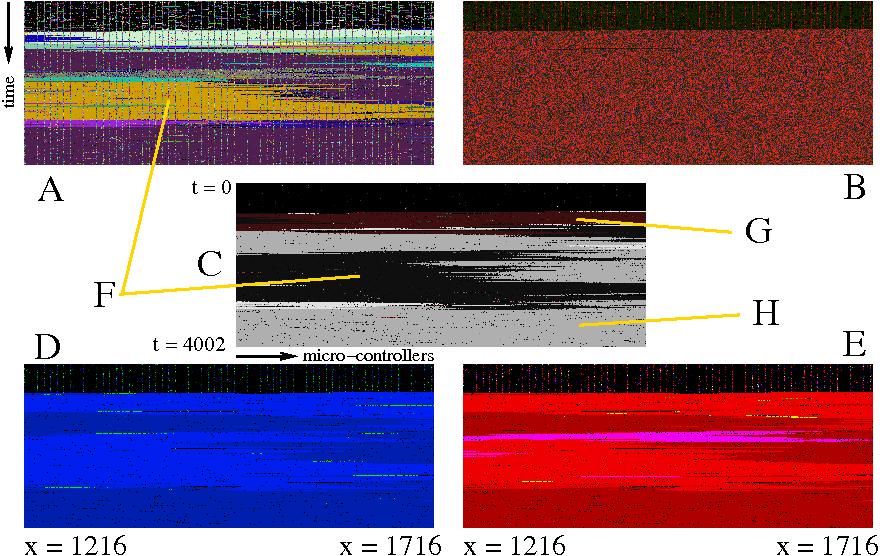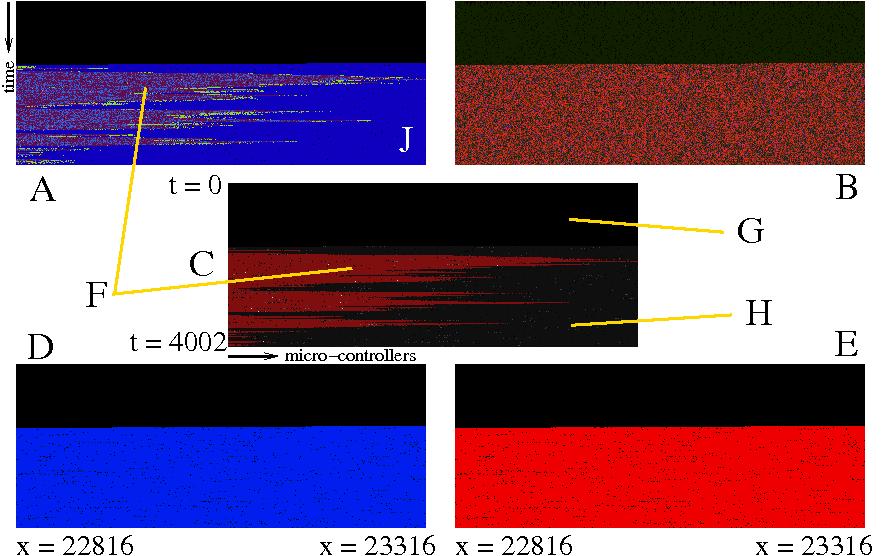Experimental results
Only very few examples of evolution will be shown because the amount of data collected is considerable. The examples shown here are available on-line [49].
Simple instruction set seeded with a set of replicators
Seeding with replicators is easily done. Shown in figure , is a fingerprint of the evolving replicators after seeding the first four containers (in the upper left corner in the figure) with minimal program shown in Table 5. More or less immediately the replicator takes over the whole system and only some minor defects occur in the middle of the experiment visible as the faint yellow and black stripes in figure . No further mutation-events or other perturbations have been subjected to the system. The fine-structure of the evolving dynamics show that aside from the replicators other program sequences are necessary as well (otherwise we would have one single color in the fingerprint). It remains to be investigated, what exactly the detailed fine-structure of the evolved programs are.
Links to the movies showing the space in full resolution: hash, register, call, energy and copy. As usual, time goes from top to bottom and the space is scanned from left to right. All five movies steem from the same experiment and represent different views on the evolving system. See the explanations in the sequel.
Simple instruction set seeded with random sequences
The experiment shown above has been conducted in a space of 4096 containers with 8 micro-controllers a container. The full evolution space is shown highly distorted. A movie can be seen online which shows the full evolving area [49]. Only two sections of this space are presented in more detail:
The micro-controllers shown start at position 1216 and end at position 1716.

Here, micro-controllers start at position 22816 and end at micro-controller 23316. These experiments were done with the simple instruction set shown in table 1, left part. What turned out during experimentation was the higher emergence probability of self-organized structures when not every micro-controller was randomized at creation but the majority of micro-controllers being left empty. The reason for this beneficial behavior is thought to be the combination of random-sequences and empty sequences which had no ability to perturb the organizing structures. This means, if replicators emerged they needed empty micro-controllers as a proliferation source. From these findings the random initialization of the micro-controllers was realized at only two micro-controllers or even less per container. This is the reason why the faint vertical stripes occur in the figures above.
Actually looking carefully at the full fingerprints of the 32768 different micro-controllers, two origins of replication can be identified. After about 400 generations the first replicator emerged, see first figure in container 1364 at location (B). Interestingly this replicator replicates every program it finds and thus, is extremely vulnerable to parasites. Later, replicators became specific which helped to increase robustness. Independently, 240 generations further-on the second replicator emerged at a different location, see second figure generation 640 in container 268, location at (A) in the first figure. This second emerging replicator is apart from non-functional instructions at the beginning a minimal replicator. This program even looses further non-functional instructions and is shown in the third figure in blue.
Movies of a further series of experiments
The following movies show the evolving micro-controllers in a series of eight experiments with identical parameters but different random-numbers. As with the movies on top of this page, time goes from top to bottom and the whole space of the 32768 micro-controllers is scanned from left two right. When no replicators did emerge then you see alternating stripe of black background - no surviving micro-controllers - and curtains of randomly initialized micro-controllers. Here only the fingerprints of the micro-controllers evolving software is shown. Different colors usually mean different programs.The movies (32768 micro-controllers in 16k generations, every 20ths generation plotted): run_961, run_962, run_963, run_964, run_965, run_966, run_967 and run_968. The according parameters and most of the spatial images can be seen in the compressed directory exp_EvoCpu_20080129.tar.gz (large! 99MB).





